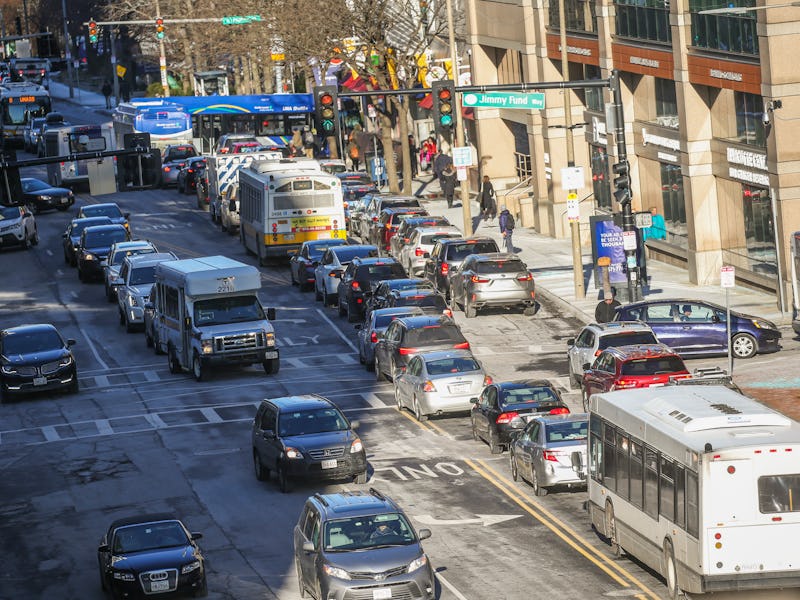New study proposes a mathematical solution to big cities' inequality problem
Building a better city starts with looking at who has access to what, and why. A new mathematical framework could help.

Cars built the modern city, but they have also made them worse places to live. Cars allow for traveling great distances to get what you need, but with those distances come the costs of travel and the toll of environmental pollution. Over time, scientists have revealed that both more negatively affect people living in more economically disadvantaged areas of cities.
Inequality of this kind existed before driving became ubiquitous, of course. But cars have harmed urbanites, eating up paychecks through gas prices, tickets, and insurance, while also raising the chances of respiratory issues and even hurting our psychological well being.
How to change this? A new study out Friday in the journal Science Advances shows that by redistributing facilities like hospitals, banks, schools, supermarkets, and parks across cities, the cost of travel could be “reduced by half.”
For this analysis, the researchers examined what is known in statistics as the “power law.” This refers to the “relationship in which a relative change in one quantity gives rise to a proportional relative change in the other quantity,” to quote the New England Complex Systems Institute.
If a side of a cube is doubled in length, for example, the cube’s volume is multiplied by a factor of eight. When applied on a city-wide scale, the power law can reveal “the equilibrium of empirical allocation of resources across cities with different population,” the study authors write. A more equal redistribution of city facilities can lead to greater accessibility for all.
In this study, the researchers concentrate on six cities: Boston, Los Angeles, and New York in the United States, and Doha, Dubai, and Riyadh in the Middle East.
“Doha and Dubai have more facilities that are located in highly populated areas, whereas Boston has the majority of facilities located near the city center where fewer people reside."
"Discrepancy in the distributions between population and facilities can also be observed in LA, NYC and Riyadh. In these three cities, the population density peaks near the city center, but the facilities are distributed more uniformly across the city,” the authors write.
The cities in the U.S. are broadly more accessible than those in the Middle East, according to this study, but there is room for improvement everywhere.
Beantown remade — Looking at a single example, the researchers focus on hospitals in Boston. Boston has over 20 hospitals serving the city, but they are unevenly distributed.
The authors find that around 11 percent of all available streets in Boston are occupied by hospitals, but their unequal distribution somewhat mirrors the distribution wealth within the city's metro area, the study authors say. In neighborhoods historically associated with economic inequality and immigration like the West End, hospitals are in short supply.
In other words, some Bostonians don't have to go far to access the healthcare facility they need, but others have to travel some distance. And those traveling the greatest distance to access these facilities tend to also be the people who are least able to afford the trip, the research suggests.
To make travel times more equitable and ensure better service and health access for all residents starts, the authors argue, by recognizing that “conditions within cities do not follow the continuous approximation for the power law.”
Facilities are unequally planned, and the number of facilities “is large in comparison with the number of populated blocks.”
The team found that “centralized cities require less facilities than polycentric cities to achieve the same levels of accessibility,” meaning that when a city generally focuses its businesses and residents in core areas, it can be easier to get resources where they’re needed.
The research could help city planners remake urban areas to encourage equity above other concerns. Historically, city growth has been chaotic. But by developing a mathematical framework to pinpoint the optimal distance between residents and the facilities they need to survive and thrive in cities, the researchers suggest that would enable metro officials to “reallocate resources that provide emergency services, such as the placement of shelters, ambulances, or mobile petrol stations in the event of natural disasters."
Essentially, planning a more equitable city shouldn't be confined to a thought experiment. It could save lives.
Such a need has come into sharp focus in 2020. At the height of the coronavirus pandemic, healthcare workers traveling to hospitals faced trips on dangerously crowded shuttles, or spending money on alternative travel means. If hospitals themselves were better distributed throughout the city, healthcare workers may not have had such perilous commutes.
Abstract: The era of the automobile has seriously degraded the quality of urban life through costly travel and visible environmental effects. A new urban planning paradigm must be at the heart of our road map for the years to come, the one where, within minutes, inhabitants can access their basic living needs by bike or by foot. In this work, we present novel insights of the interplay between the distributions of facilities and population that maximize accessibility over the existing road networks. Results in six cities reveal that travel costs could be reduced in half through redistributing facilities. In the optimal scenario, the average travel distance can be modeled as a functional form of the number of facilities and the population density. As an application of this finding, it is possible to estimate the number of facilities needed for reaching a desired average travel distance given the population distribution in a city.
This article was originally published on